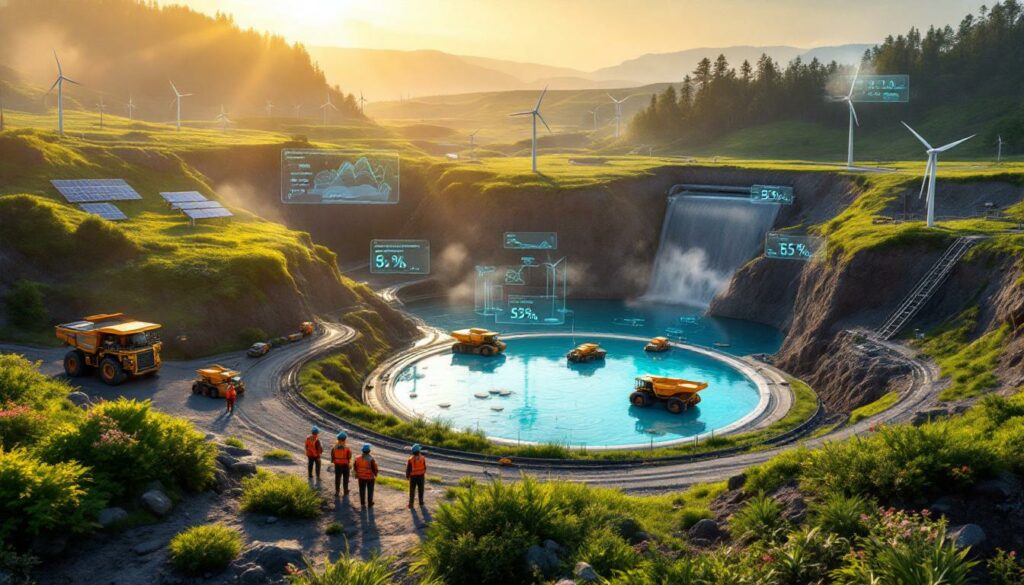Reimagining Mine Sites in the Decarbonisation Age: Sustainable Transformation Strategies
Mining operations worldwide are undergoing radical transformation as the industry faces mounting pressure to align with global climate goals. With traditional mining practices contributing significantly to global emissions, companies are now exploring innovative approaches to reduce their environmental footprint while maintaining economic viability.
The mining sector stands at a crossroads where sustainability isn't just desirable but essential for survival in a carbon-constrained world. This transformation represents both challenge and opportunity—reimagining mine sites in the decarbonisation age with sustainability at their core.
How Are Mining Companies Adapting to Decarbonisation Demands?
The Shifting Landscape of Mining Operations
The global mining industry currently contributes approximately 4-7% of global greenhouse gas emissions, a significant footprint that has placed the sector under intense scrutiny. This carbon intensity stems primarily from energy-intensive processes, heavy reliance on diesel-powered equipment, and legacy operational designs that prioritized production efficiency over environmental considerations.
Mining operations are evolving from isolated extraction sites to integrated energy and resource systems. Companies are implementing comprehensive carbon accounting practices, setting science-based emission reduction targets, and incorporating sustainability metrics into operational performance indicators.
Regulatory frameworks across major mining jurisdictions are tightening, with many introducing carbon pricing mechanisms, mandatory emission reporting, and stricter environmental impact assessment requirements. Countries including Canada, Australia, and Chile have introduced climate-focused mining regulations that are reshaping operational parameters.
"The mining industry is undergoing its most significant transformation since mechanization. Companies that embrace decarbonisation as a core business strategy rather than a compliance exercise will emerge as the industry leaders of tomorrow." — Mining sustainability expert
Economic Pressures and Funding Challenges
The funding landscape for new mining projects has shifted dramatically, with ESG (Environmental, Social, and Governance) compliance now a fundamental requirement for accessing capital. Major investment funds are systematically divesting from high-carbon operations while increasing allocations to companies demonstrating clear industry evolution trends.
Initial capital expenditure for sustainable mining operations typically exceeds traditional models by 15-30%, primarily due to investments in renewable energy infrastructure, electrified equipment, and advanced water management systems. However, operational expenditure over mine life can be reduced by up to 25% through lower energy costs, reduced water consumption, and minimized rehabilitation requirements.
A comparative analysis of financial performance between early sustainability adopters and traditional operators reveals compelling evidence that green mining pays dividends. Companies with comprehensive sustainability programs have demonstrated:
- 22% lower cost of capital on average
- 18% higher valuation multiples
- 35% reduced regulatory compliance costs
- Significantly enhanced community relations, reducing project delays
What Makes a Truly Green Mining Project?
Beyond Greenwashing: Core Elements of Sustainable Mining
Truly sustainable mining operations extend far beyond carbon reduction to encompass holistic environmental and social performance. Key performance indicators include:
-
Water stewardship: Advanced mining operations have achieved water consumption reductions of 50-60% through closed-loop systems, precision application technologies, and treatment innovations that enable near-total water recycling.
-
Biodiversity protection: Leading operations now implement science-based biodiversity management that delivers measurable net positive impacts through habitat creation, invasive species management, and wildlife corridor preservation during active mining.
-
Waste minimization: Circular economy approaches have enabled pioneering mining companies to reduce waste rock storage by up to 40% through innovative beneficiation, repurposing, and waste management solutions.
| Aspect | Traditional Mining | Next-Generation Sustainable Mining |
|---|---|---|
| Energy Source | Primarily fossil fuels | Renewable energy with storage systems |
| Equipment | Diesel-powered | Battery electric vehicles |
| Water Management | High consumption, discharge | Closed-loop recycling, minimal freshwater use |
| Waste | Large footprint storage | Resource recovery, progressive rehabilitation |
| Community | Transactional relationship | Partnership and co-development |
| Land Use | Sequential rehabilitation | Concurrent operations and restoration |
| Closure | Remediation after operations | Progressive rehabilitation throughout mine life |
Renewable Energy Integration in Mining Operations
Renewable energy adoption has accelerated dramatically across the mining sector, with industry leaders achieving 70-80% renewable penetration at select operations. Solar installations at mine sites have grown exponentially, with typical arrays now ranging from 20-100MW depending on operational requirements.
Wind energy has proven particularly compatible with mining operations in regions with favorable wind resources, delivering electricity at costs as low as $0.04 per kWh—significantly below diesel generation costs that can exceed $0.30 per kWh in remote locations.
Battery energy storage systems (BESS) have emerged as critical enabling technology, with installations ranging from 10-50MWh becoming standard at renewable-powered mine sites. These systems provide the stability and reliability necessary for maintaining consistent operations while maximizing renewable utilization.
Disclaimer: Renewable energy implementation timelines and financial returns vary significantly based on geographic location, regulatory frameworks, and specific operational requirements. The statistics provided represent industry benchmarks rather than guaranteed outcomes for all mining operations.
How Can Existing Mine Sites Be Transformed?
Repurposing Infrastructure for Renewable Energy Generation
Abandoned mine pits present remarkable opportunities for pumped hydro storage, with typical systems capable of delivering 200-1000MW of dispatchable power capacity. The elevation differences in these sites provide natural advantages for energy storage, with some converted mines achieving round-trip efficiencies exceeding 80%.
Rehabilitated mine lands offer optimal conditions for solar development, with flat, cleared areas enabling efficient panel placement. Several former mining operations have successfully deployed solar arrays generating 50-200MW, with installation costs approximately 15% below greenfield solar developments due to existing infrastructure and grid connections.
Wind farm development on elevated mine sites has demonstrated capacity factors 10-15% higher than surrounding areas due to terrain-enhanced wind resources. These projects benefit from existing access roads, transmission infrastructure, and disturbed landscapes that minimize additional environmental impacts.
Case Study: Kidston Pumped Storage Hydro Project
The former Kidston Gold Mine in Queensland, Australia exemplifies successful mine transformation, converting twin mining pits into a 250MW/2000MWh pumped hydro facility integrated with a 320MW solar farm. This project demonstrates how mining infrastructure can be repurposed to support electrification powering mines while providing economic benefits to former mining communities.
Mine Waste to Valuable Resources
Tailings reprocessing technologies have advanced significantly, enabling extraction of valuable minerals that were previously unrecoverable. Operations applying these innovations have recovered:
- Gold and silver at grades as low as 0.3-0.5 g/t
- Copper from tailings containing 0.1-0.3%
- Rare earth elements from historic processing waste
- Critical battery minerals including lithium, cobalt, and manganese
Carbon sequestration in mine waste represents an emerging opportunity, with research demonstrating that certain mine tailings can naturally absorb CO₂ when exposed to air. Enhanced weathering techniques have accelerated this process, enabling some operations to sequester up to 0.5-1 ton of CO₂ per ton of processed tailings.
The economic potential of waste reprocessing is substantial, with comprehensive analyses indicating value creation potential of $30-120 per ton of reprocessed material depending on mineral content, extraction efficiency, and market conditions.
What Technologies Are Enabling Sustainable Mining?
Automation and Digitalization
Remote operations centers have revolutionized mining efficiency, reducing on-site personnel requirements by 30-50% while maintaining or improving production rates. These centralized facilities enable specialized expertise to be applied across multiple operations simultaneously, optimizing resource allocation and reducing travel-related emissions.
AI in mining operations is delivering energy consumption reductions of 15-30% by:
- Dynamically adjusting processing parameters based on ore characteristics
- Optimizing haul truck routing and loading to minimize fuel consumption
- Precisely controlling ventilation systems in underground operations
- Predicting and preventing equipment failures that cause energy-intensive restarts
Digital twin technology has enabled sophisticated environmental impact modeling, with simulations capable of predicting and mitigating potential issues before they occur. These systems integrate thousands of environmental sensors with meteorological data and hydrological models to provide real-time environmental management capabilities.
Breakthrough Extraction Technologies
In-situ recovery techniques represent perhaps the most promising frontier in sustainable mining, enabling mineral extraction with minimal surface disturbance. These methods:
- Reduce water consumption by up to 90% compared to conventional mining
- Eliminate the need for waste rock dumps and tailings facilities
- Decrease energy requirements by 40-60%
- Minimize habitat disruption and rehabilitation requirements
| Extraction Method | Environmental Footprint Reduction | Application Limitations | Technology Readiness |
|---|---|---|---|
| In-situ leaching | 70-90% reduced surface disturbance | Limited to suitable geology and minerals | Commercial deployment |
| Biomining | 40-60% reduced chemical use | Lower recovery rates for some minerals | Early commercial |
| Electrochemical extraction | 50-70% reduced water use | Higher capital costs, specific minerals | Demonstration phase |
| Precision blasting | 20-30% reduced energy consumption | Requires advanced monitoring systems | Commercial deployment |
Chemical-free processing alternatives have made significant advances, with methods including gravity separation, dry sorting, and direct lithium extraction reducing or eliminating traditional chemical reagents while maintaining acceptable recovery rates for many minerals.
How Are Companies Managing Community Relations in the Decarbonisation Era?
Stakeholder Engagement Strategies
Indigenous partnerships have evolved from transactional consultation to collaborative development models, with leading companies implementing formal co-management agreements that provide Indigenous communities with meaningful oversight and participation in environmental management decisions.
Transparent environmental performance reporting has become standard practice, with real-time monitoring data increasingly made available to community stakeholders through accessible digital platforms. These systems allow local communities to independently verify compliance with environmental commitments and participate in adaptive management processes.
Case Study: Community-Integrated Mining Operations
Several mining operations have pioneered community integration approaches that deliver substantial shared value. These models typically involve:
- Community equity participation ranging from 5-30%
- Formalized environmental co-management structures
- Skills development programs aligned with mine transformation needs
- Collaborative land-use planning for progressive rehabilitation
Just Transition Planning for Mining Communities
The shift toward sustainable mining necessitates comprehensive workforce transition planning. Leading companies have implemented skills development programs focused on:
- Renewable energy system installation and maintenance
- Environmental monitoring and rehabilitation techniques
- Digital technology operation and data analysis
- Circular economy and waste valorization processes
Statistical analysis of employment outcomes in regions implementing comprehensive transition programs shows promising results:
- 65-80% of displaced mining workers successfully transitioning to alternative employment
- Local unemployment rates returning to pre-closure levels within 3-5 years
- Diversification of regional economies with reduced dependence on single industries
- Increased local business formation rates of 15-25% compared to regions without transition planning
What Are the Leading Examples of Mine Site Transformation?
Case Study: Lithium Extraction with Minimal Environmental Impact
Geothermal brine extraction methods represent a revolutionary approach to lithium production, with several operations now recovering lithium from geothermal fluids that would otherwise be reinjected without resource recovery. This process:
- Produces zero mining waste
- Requires minimal land disturbance
- Utilizes renewable geothermal energy for processing
- Generates multiple mineral products from a single resource
According to Mining Magazine's analysis on decarbonisation, direct lithium extraction technologies have achieved commercial viability, enabling lithium recovery from brines with 70-90% lower water consumption compared to traditional evaporation pond methods. These processes reduce land requirements by approximately 85% while accelerating production timelines from 18 months to less than 24 hours.
Environmental performance metrics from leading operations demonstrate substantial advantages compared to conventional hard-rock lithium mining:
- Carbon footprint reductions of 80-95%
- Water consumption reductions of 50-90%
- Complete elimination of overburden and waste rock
- Dramatically reduced chemical reagent requirements
Case Study: Copper Mine Rehabilitation and Repurposing
Several copper mining operations have implemented progressive rehabilitation approaches that deliver superior environmental outcomes. These systems integrate active mining with concurrent land restoration through:
- Topsoil preservation and enhancement techniques
- Native seed banking and revegetation
- Hydrological system restoration during operations
- Wildlife corridor maintenance throughout the mine life
Biodiversity monitoring at rehabilitated mine sites has documented remarkable recovery, with some operations achieving:
- 110-130% of pre-mining species diversity
- Successful reestablishment of sensitive indicator species
- Creation of specialized habitats for threatened species
- Enhanced ecosystem services including water filtration and carbon sequestration
As reported by Mining Monthly's analysis of Australian mining's path to net zero, multi-use post-mining landscapes have demonstrated substantial economic benefits, with comprehensive analyses indicating value creation of $20,000-50,000 per hectare through integrated land uses including renewable energy generation, tourism, agriculture, and conservation.
What Policy Frameworks Support Mine Site Transformation?
International Standards and Certification
Leading sustainability certification frameworks have evolved to address mining-specific challenges, with standards now incorporating:
- Science-based carbon reduction targets
- Biodiversity net gain requirements with quantifiable metrics
- Water stewardship across watershed systems
- Circular economy principles for waste management
- Community development and economic transition planning
Carbon accounting methodologies for mining operations have become increasingly sophisticated, with life-cycle assessments now capable of accurately quantifying emissions across:
- Exploration and development activities
- Construction and infrastructure development
- Operational processes and transportation
- Processing and refining activities
- Closure and post-closure phases
Government Incentives and Requirements
Innovative rehabilitation bond mechanisms are transforming closure planning, with progressive rehabilitation incentives reducing financial assurance requirements as environmental milestones are achieved. These systems have demonstrated 15-25% reductions in overall financial assurance requirements while improving environmental outcomes.
Public-private partnerships for mine transformation have proven particularly effective, combining government funding with private expertise to implement ambitious repurposing projects. Successful models typically involve:
- Government provision of baseline environmental data and technical support
- Private sector expertise in renewable energy development
- Shared investment in infrastructure modernization
- Community stakeholders in governance structures
Policy effectiveness analysis across major mining jurisdictions indicates that the most successful regulatory frameworks combine:
- Clear performance standards rather than prescriptive requirements
- Financial incentives aligned with sustainability outcomes
- Mandatory transparency and reporting mechanisms
- Adaptive management provisions that enable innovation
FAQ: Sustainable Mining Transformation
What is the average carbon footprint reduction potential for mine site transformation?
Comprehensive data across different mining sectors indicates carbon footprint reduction potential of:
- 40-60% achievable within 5 years through operational efficiency, renewable energy integration, and electrification of mobile equipment
- 60-80% achievable within 10 years through comprehensive transformation including process redesign and innovative extraction methods
- 80-95% achievable within 15-20 years through breakthrough technologies and circular systems integration
The technologies driving the largest emissions reductions include:
- Renewable energy microgrids (20-30% reduction)
- Battery electric vehicles (15-25% reduction)
- Process electrification (10-20% reduction)
- AI-optimized operations (5-15% reduction)
- Alternative extraction methods (20-40% reduction)
How do sustainable mining practices affect operational costs?
Initial investment requirements for comprehensive sustainability transformation typically range from $50-150 million for mid-sized operations, representing a 15-30% premium over traditional approaches. However, this capital allocation delivers multiple financial benefits:
- Energy cost reductions of 20-40% through renewable integration
- Water management savings of 15-30% through recycling and efficiency
- Waste management cost reductions of 10-25% through valorization
- Regulatory compliance cost reductions of 30-50%
- Community relations cost reductions of 40-60% through reduced conflicts
Payback periods for major sustainability investments vary significantly by technology:
| Technology | Typical Payback Period | IRR Range | Risk Factors |
|---|---|---|---|
| Solar PV | 4-7 years | 12-18% | Weather variability, policy changes |
| Battery storage | 5-8 years | 10-15% | Technology evolution, cycling degradation |
| Electric vehicles | 3-6 years | 15-22% | Battery life, charging infrastructure |
| Water recycling | 2-4 years | 20-35% | Processing chemistry compatibility |
| Digital systems | 1-3 years | 25-40% | Implementation complexity, staff adoption |
Disclaimer: Financial returns from sustainability investments vary significantly based on operation scale, location, commodity, and implementation approach. The figures presented represent industry benchmarks rather than guaranteed outcomes.
What skills are needed for the future mining workforce?
The sustainable mining transition requires a significant evolution in workforce capabilities, with growing demand for:
- Digital literacy: Data analysis, automation management, remote operations, predictive modeling
- Environmental management: Rehabilitation techniques, ecosystem monitoring, biodiversity assessment, water quality management
Ready to Invest in Sustainable Mining Innovations?
Discover the next generation of mining companies pioneering decarbonisation strategies and mine site transformations with Discovery Alert's proprietary Discovery IQ model, which delivers real-time notifications on significant ASX mineral discoveries and emerging opportunities in the sustainable mining space. Visit our discoveries page to understand how transformative mineral announcements can lead to substantial investment returns.




